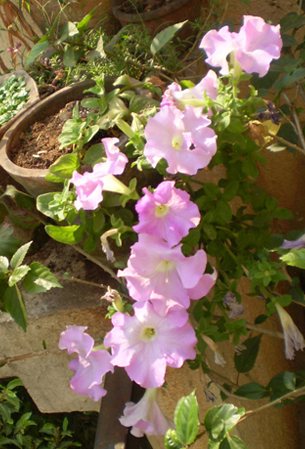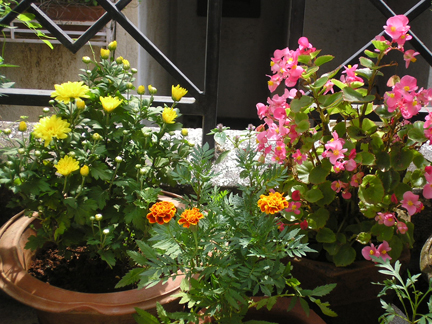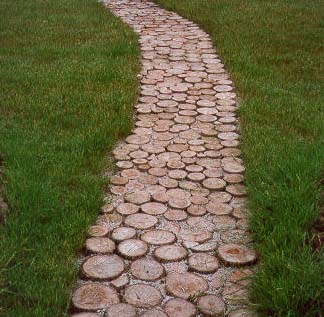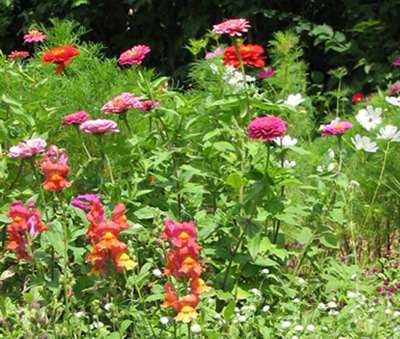Prepare Your Garden For The Spring
Yesterday the twig was brown and bare; 
Tomorrow will be leaflets spare;
I know no thing so wondrous fair,
No miracle so strangely rare.
I wonder what will next be there! ~~L.H. Bailey
I love this particular verse by Bailey and was reminded of it once again when I saw the tiny green buds on my jasmine plant yesterday morning. My jasmine was looking dismally bare and sad since I had pruned it down very deeply last week, one of my regular yearly chores between the end of February and the beginning of March. The verse also reminded me of the various activities that I needed to start now which I am sure almost all of avid gardeners must have started in their gardens.
Even though conditions in India at the beginning of spring is not as bare or barren as it in Western countries, there is still a lot of work that needs to be done around your garden. Because even though we have no frost here, except of course in the Northern states, the plants are still waking up from their winter slumber and dormancy. There is a lot of back breaking work involved now, but the colours and fragrances that follow in summer, every drop of sweat is worth it. The mere satisfaction of looking at beautiful blooms produced in summer is worth a treasure in gold.
Most of work that you need to focus in your garden is towards giving it a thorough spring cleaning, yes like houses, even gardens need that! The plants need to be tidied up well so that they can breathe freely and get space to grow out properly. If the tidying is given a miss, then you won’t get desired results and the plants will not look lush and beautiful.
Here are a few must-dos and tips that need to be followed to achieve a beautiful, lush garden:
Sprucing Up Your Garden
Tidying up involves clearing out all the dead, fallen branches and leaves. Also cut out all the dead branches from your trees, shrubs and ornamentals etc. If any dried plants are left from earlier year, now is the time to pull them out. All of these dried branches, plants etc. should be put in a pile for starting your own compost, do not waste even a single piece of twig or a leaf. All of this contains precious nutrients that are required to condition your soil and for the future plants. But look carefully for diseases. If the branches or plants look diseased, burn them up in a separate pile in a faraway corner so as to avoid spread to healthy plants. The already growing plants or shrubs will need to be pruned down now to continue their luxuriant growth since the growth of plants over winter is usually slow. A deep pruning now will ensure that the foliage in summer will be very luxurious and healthy. Another aspect of cleaning involves weeding your garden as the weeds are still young and easy to pull out. Never use a chemical weed killer later as it may compromise the quality of the soil and also may destroy delicate plants. Instead pull them from their roots, cut them up in pieces and throw in compost pile.

Making Compost
Start your compost pile by digging a pit and layering it with soil and waste from the garden such as leaves, branches, dead plants etc. if you have a large garden and lot of space for the compost pit, then you can put your kitchen waste into this too. Just ensure that the vegetables, fruit peels etc. that you are putting in the pit are chopped finely and not big pieces. This will speed up the decomposition and make compost faster. Ensure that all the waste you are putting in compost pile are healthy and free of diseases or else the quality of compost will be compromised. Keep the pile moist by spraying water over it occasionally. Do not over water as there is danger of the waste rotting instead of decomposing properly, just spray enough water to keep the pile moist. Also, the layers need to be turned around occasionally so that all layers get air to breathe. Do not pack the layers hard but keep them loose to allow entry of air in them. Normally when a new compost pile is made, if all the conditions are right and you are taking all steps properly, the compost will be produced effortlessly, but if you have any doubts or some trouble, it is better to add a starter to the pile which you can obtain from any plant nursery.
It is also a good idea to introduce a few earthworms in the pile. The earthworms eat the garden and kitchen waste and in turn their droppings are highly nutritious and beneficial for the plants. These dropping also help make the soil more porous and condition it well. This is nothing but the vermiculture that we hear about so often. But you have to be careful enough to keep the layers of soil and waste moist and well aerated or else the earthworms may die. Also, abstain from adding any pesticides or insecticides to it to keep away insects and ants etc. as the chemicals kill the earthworms. If you notice ants etc. around it, just spread turmeric powder over it to get rid of ants.
Mending and Repairing Work around the Garden
 If your garden has wooden fencing, wooden trellises, gates, benches etc. now is the time to look at them as rains may have done a lot of damage to them. If you are living in places where winter is harsh, then that too damages wooden structures. So now is the when you should check all these and see what is needed to be done. Any bore holes made by bugs etc. will need to be filled in using putty. Then apply a good quality weather proof wood polish and let it dry well. If desired, you may apply bright colours over it. Tighten loose screws or hinges and oil them if necessary. If you have created special features in your garden like waterfalls, small water ponds, or garden paths, check them if all the components are in place as rains may disrupt them out of place. Repair them and put them back in place as necessary. Any new structure that you want may be added now before you get down to planting. iron wire meshes will also need to be checked and repaired as necessary.
If your garden has wooden fencing, wooden trellises, gates, benches etc. now is the time to look at them as rains may have done a lot of damage to them. If you are living in places where winter is harsh, then that too damages wooden structures. So now is the when you should check all these and see what is needed to be done. Any bore holes made by bugs etc. will need to be filled in using putty. Then apply a good quality weather proof wood polish and let it dry well. If desired, you may apply bright colours over it. Tighten loose screws or hinges and oil them if necessary. If you have created special features in your garden like waterfalls, small water ponds, or garden paths, check them if all the components are in place as rains may disrupt them out of place. Repair them and put them back in place as necessary. Any new structure that you want may be added now before you get down to planting. iron wire meshes will also need to be checked and repaired as necessary.
Sharpen and Maintain Your Tools
Get out your tools and repair them and sharpen them as is necessary. If you have motorized tools such as lawnmowers, you may want to get them serviced and oiled before putting it to use in summer. Check and replenish the tools in you inventory as may be necessary. It is a good idea to decide what you are going to plant this year which will give a fair idea of any special tools you might need to buy.
Pruning and Dead Heading
The flowering bushes and ornamentals etc. should be pruned now. Especially for flowering bushes like roses, jasmine etc. they should be deeply pruned, meaning all thin branches should be cut very low and keeping only the main thik branch intact. Remaining all thin branches should be removed. The cutting should be done very carefully wiith a slanted angle and a clean, sharp cut. Take care to not damage the main thick stem of the plant. This will ensure the new branches in profusion and will grow very healthy. Deadhead all flowers that are from previous season. Deadheading ensures profusion of blooms in the coming summer. Put all these branches and dead flowers in the compost pile, but again, check for any diseases before you do that.
Preparing and Building Beds
The existing beds for flowers, vegetable etc. need to be refurbished. Turn only the top layer of soil well with the help of a shovel or hoe and remove any remaining dead roots etc. from the soil. Add manures and fertilizers etc. to the soil and give it a good soak. Adding organic fertilizers is a good idea instead of chemical ones. As far as possible abstain from chemical preparations. Putting in the traditional ‘Neem ki khali’ which is the contents left of Neem fruits after removing oil, is the best idea, because Neem ki khali is a very good plant food, it conditions soil very well and also its antiseptic and medicinal properties keep a number of bugs, insects and diseases away. if you have a Neem tree in your garden, then you can also use crushed neem leaves and twigs for this purpose. If you have fruit trees in your garden, now is the best time to feed them with fertilizers, best of course being the organic ones.
Planting and Sowing
After you are through with the cleaning and mending jobs, plant new saplings, seeds etc. However, if you happen to be located in extremely cold, chilly areas, make sure that the ground is completely thawed out before planting new plants or else the frost may kill young saplings. Now is the time when you also decide any bulbs you may have. The existing old bulbs develop small babies around them making it very crowded, thus competing for nutrition. So remove and divide these bulbs and spread them around. If you get more bulbs than you actually want, it is a good idea to swap them with friends for other varieties of bulbs and seeds you may not have. This is a good way to get more colour in your garden and is very economical too rather than buying expensive bulbs and saplings from nursery.
Start A Vegetable Garden
Freshly plucked produce from your own garden is a great way to get those much-needed nutrients while ensuring they are free from chemicals. Best ones to plant now and get a good summer crop are chillies, peppers, tomatoes, beans etc. Start the seeds in shallow containers and then move to prepared beds after the saplings are a couple of inches tall. Provide support in the form of stakes or wired frames etc. especially to tomatoes and beans.

Whew! A very long list of to-do things and quite exhausting also. But once you are through with these jobs, you can sit back and relax, only for a while as there is no dearth of things that would need your immediate attention once everything you have planted starts growing. But once the flowers start blooming, you can really feel the joy and smell the sweet smell of your success, and what’s more, taste it too!!
Image Source: Wikimedia Commons and Author's Own
Like it on Facebook, Tweet it or share this article on other bookmarking websites.

